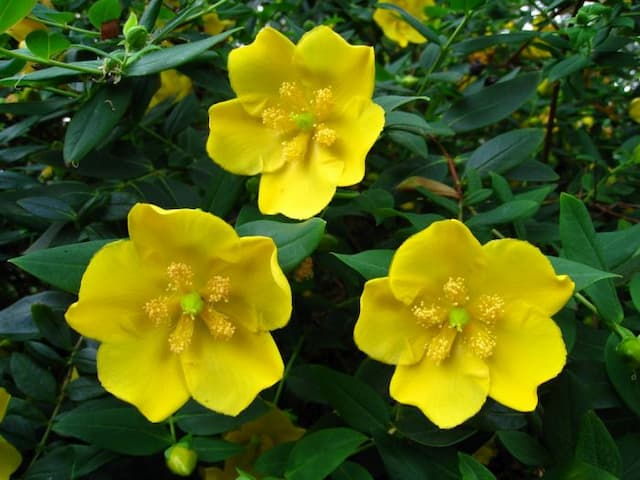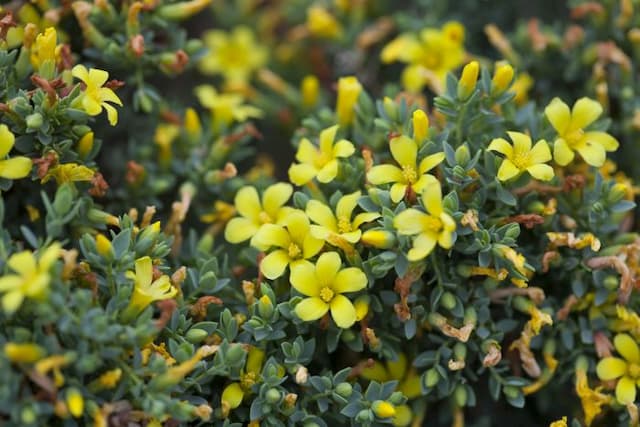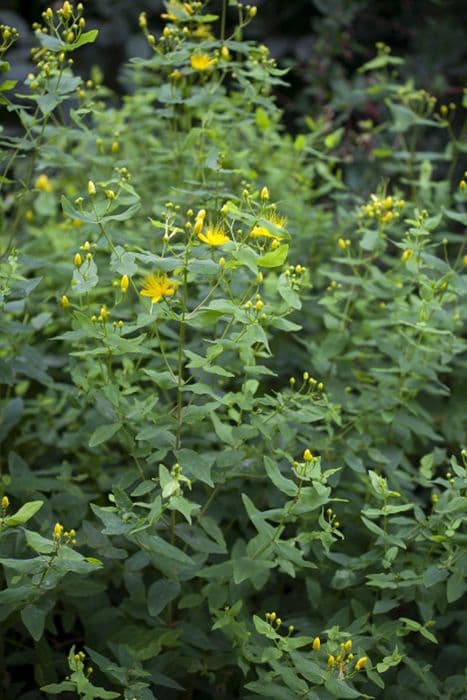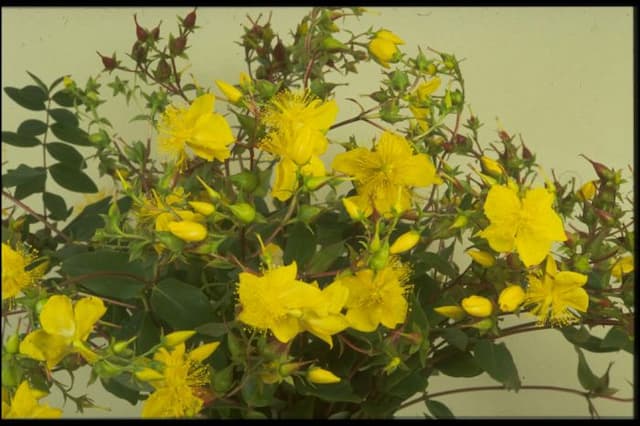Olympic St. John's Wort Hypericum olympicum f. uniflorum 'Citrinum'

ABOUT
Hypericum olympicum f. uniflorum 'Citrinum', commonly known as the Olympic St. John's Wort, is notable for its attractive, ornamental qualities. The plant bares bright, lemon-yellow flowers that provide a cheerful and eye-catching display. Each flower exhibits a multitude of stamen that radiate from the center, creating a prominent, bushy appearance which is quite distinctive. The blossoms are bold and single, supported by woody, branching stems which give the plant a sturdy structure. The foliage of the Olympic St. John's Wort is equally appealing, comprised of small, narrow leaves that cling close to the stems. These leaves are typically a blue-green to gray-green in color, adding an interesting contrast to the vibrant yellow flowers. Their dense disposition along the stems contributes to the plant's overall lush appearance. This plant typically blooms in the summer months, creating a period of striking visual interest in gardens or landscapes where it is featured. Overall, Olympic St. John's Wort is appreciated for its vibrant color and ability to attract pollinators like bees and butterflies, contributing to the biodiversity of the garden environment.
About this plant
 Names
NamesFamily
Hypericaceae
Synonyms
Olympic St. John's Wort, Citrine St. John's Wort
Common names
Hypericum olympicum f. uniflorum 'Citrinum'.
 Toxicity
ToxicityTo humans
The common name of Hypericum olympicum f. uniflorum 'Citrinum' is Olympic St. John's Wort. Generally, St. John's Wort is considered to have low toxicity for humans. However, ingesting large quantities can lead to some adverse effects such as gastrointestinal discomfort, dizziness, confusion, and increased sensitivity to sunlight. It may also interact with various medications, altering their effectiveness. Therefore, although considered to have low toxicity, caution should be exercised when ingesting any part of the plant, especially if you are on medication or consuming it in large amounts.
To pets
Olympic St. John's Wort can be toxic to pets, particularly dogs and cats. If ingested, it can cause similar symptoms as it does in humans, including gastrointestinal upset, lethargy, and photosensitivity, leading to skin irritation when exposed to sunlight. Additionally, in some cases, it could result in more severe reactions such as nerve damage or impact the heart. Any ingestion by pets should be taken seriously, and a veterinarian should be consulted immediately to manage the symptoms and prevent potential complications.
 Characteristics
CharacteristicsLife cycle
Perennials
Foliage type
Evergreen
Color of leaves
Green
Flower color
Yellow
Height
1 foot [30 cm]
Spread
1 foot [30 cm]
Plant type
Shrub
Hardiness zones
5
Native area
Turkey
Benefits
 General Benefits
General Benefits- Aesthetic Appeal: Hypericum olympicum f. uniflorum 'Citrinum', commonly known as the 'Citrinum' St. John's Wort, produces bright yellow flowers, adding a splash of color to gardens and landscapes.
- Low Maintenance: This plant variety is known for being drought-tolerant and requires minimal care once established, making it suitable for low-maintenance landscaping.
- Attracts Wildlife: The flowers can attract pollinators such as bees and butterflies, which are beneficial for pollinating gardens.
- Ground Cover: Its dense foliage can help cover bare spots in the garden, reducing soil erosion and suppressing weeds.
- Rock Gardens: 'Citrinum' St. John's Wort is an ideal choice for rock gardens due to its ability to grow in rocky, well-drained soil and its compact growth habit.
- Border Planting: Its uniform growth and striking flowers make it suitable for borders and edging in garden designs.
 Medical Properties
Medical PropertiesThis plant is not used for medical purposes.
 Air-purifying Qualities
Air-purifying QualitiesThis plant is not specifically known for air purifying qualities.
 Other Uses
Other Uses- Hypericum olympicum f. uniflorum 'Citrinum', commonly known as the Olympic St. John's Wort, can be used as a natural fabric dye, producing varied shades of yellow and green depending on the mordant used.
- In garden design, this plant's compact growth habit and bright yellow flowers can be utilized to create stunning rock garden features or to add visual interest to alpine garden collections.
- The plant's essential oils may be extracted and used for scenting candles and natural perfumes with its subtle, herbaceous fragrance.
- Olympic St. John's Wort can be dried and incorporated into decorative potpourri mixes to provide not only visual appeal but also a light, pleasant scent to a room.
- The branching structure and vibrant flowers make it a candidate for creating miniature wreaths and other small floral arrangements.
- Its dense foliage and flowering habit provide a natural habitat and food source for beneficial garden insects, particularly bees and butterflies.
- Photographers and artists may use the plant as a subject for botanical illustrations or macro photography, capturing the intricate details of its flowers and leaves.
- Due to its drought tolerance, Olympic St. John's Wort can be used in xeriscaping, helping to conserve water in gardens and landscapes in arid regions.
- The plant can be used in educational settings as an example of a perennial herbaceous plant, demonstrating its lifecycle and role in the ecosystem to students.
- Olympic St. John's Wort, with its burst of color, can be used to counteract garden color slumps, providing a pop of color when other plants in the garden have ceased blooming.
Interesting Facts
 Feng Shui
Feng ShuiSt. John's Wort is not used in Feng Shui practice.
 Zodiac Sign Compitability
Zodiac Sign CompitabilitySt. John's Wort is not used in astrology practice.
 Plant Symbolism
Plant Symbolism- Protection: Hypericum, commonly known as St. John's Wort, has long been associated with warding off evil spirits and negative energies. This tradition dates back to medieval times.
- Healing and Medicinal Properties: St. John's Wort is well-known for its use in herbal medicine, particularly for treating depression and wounds, symbolizing physical and emotional healing capabilities.
- St. John the Baptist: The plant is traditionally harvested on St. John's Day (June 24th), and it's believed to bloom around the time of his birthday, thus, symbolizing birth and new beginnings.
- Light and Sun: The bright, yellow flowers of St. John's Wort are reflective of the sun and light, representing positivity, happiness, and the power to banish darkness.
- Strength And Resilience: Given its ability to thrive in poor soil conditions, St. John's Wort also stands for the ability to endure and overcome challenges.
 Water
WaterThe plant commonly known as Olympic St. John's Wort should be watered deeply but infrequently, allowing the soil to dry out between waterings. As a general rule, provide about one gallon of water every 7 to 10 days during the active growing season, reducing frequency in the winter months. It is important to avoid overwatering, as this can lead to root rot. Always check the top two inches of soil for dryness before watering again.
 Light
LightOlympic St. John's Wort thrives in full sun to partial shade. It should be placed in a spot where it receives at least 6 hours of direct sunlight per day, but it can tolerate some afternoon shade, especially in hotter climates. Avoid deep shade, as this can result in fewer flowers and a leggy growth habit.
 Temperature
TemperatureThe Olympic St. John's Wort fares well in a wide range of temperatures but prefers a temperate climate. It can survive in temperatures as low as 0°F and as high as 80°F, though it grows best when daytime temperatures are between 60°F and 70°F. Protect it from extreme cold by mulching in the winter if necessary.
 Pruning
PruningPruning Olympic St. John's Wort is done to shape the plant, remove dead or diseased wood, and encourage bushier growth. Prune in early spring before new growth starts, removing up to one-third of the oldest stems to rejuvenate the plant. Light trimming can also be done after flowering to maintain shape.
 Cleaning
CleaningAs needed
 Soil
SoilThe best soil mix for Olympic St. John's Wort (the common name for Hypericum olympicum f. uniflorum 'Citrinum') is a well-draining, sandy or loamy soil with good organic matter content. This plant prefers a slightly acidic to neutral pH, ranging from 5.5 to 7. Amending with compost or peat moss can enhance soil fertility and structure.
 Repotting
RepottingOlympic St. John's Wort typically does not require frequent repotting; every 2-3 years is usually sufficient. When roots become crowded, choose a slightly larger pot to allow for continued growth. Repot in late winter or early spring before new growth begins.
 Humidity & Misting
Humidity & MistingOlympic St. John's Wort thrives in moderate humidity levels, typical of outdoor conditions. While it can adapt to lower humidity, striving for 40-50% relative humidity is beneficial, especially when grown indoors to mimic its natural environment.
 Suitable locations
Suitable locationsIndoor
Place in bright, indirect light and water moderately.
Outdoor
Plant in full sun to part shade in well-draining soil.
Hardiness zone
5-9 USDA
 Life cycle
Life cycleHypericum olympicum f. uniflorum 'Citrinum' commonly referred to as 'Olympic St. John's Wort', begins its life cycle as a seed that germinates in the spring under the right conditions of warmth and moisture. The seedling then develops into a young plant with distinctive foliage and, given the sufficient light, water, and nutrients, it will grow and mature into an adult plant. During the late spring or early summer, the plant produces bright yellow, cup-shaped solitary flowers that attract pollinators. After pollination, these flowers develop into capsules containing numerous seeds by late summer. Once the seeds mature, they are dispersed by environmental factors such as wind or animals. The plant may die back in winter, entering a period of dormancy, but with the arrival of favorable conditions in the next spring, it may regrow from the root system or the cycle can begin anew with the germination of seeds.
 Propogation
PropogationPropogation time
Early Spring
Propogation: Hypericum olympicum f. uniflorum 'Citrinum', commonly known as Golden Cup St. John's Wort, is most successfully propagated using softwood cuttings. This method is popular due to its simplicity and effectiveness. The best time to take cuttings is in late spring to early summer when new growth is just beginning to harden but is still flexible. Cut a 4 to 6-inch (about 10 to 15 cm) length of stem, ensuring there are several leaf nodes, and remove the lower leaves. Dip the cut end into rooting hormone to encourage root development and place the cutting into a well-draining potting mix. Maintain consistent moisture and provide indirect light until roots have established, after which the new plants can be transplanted into their final location.









